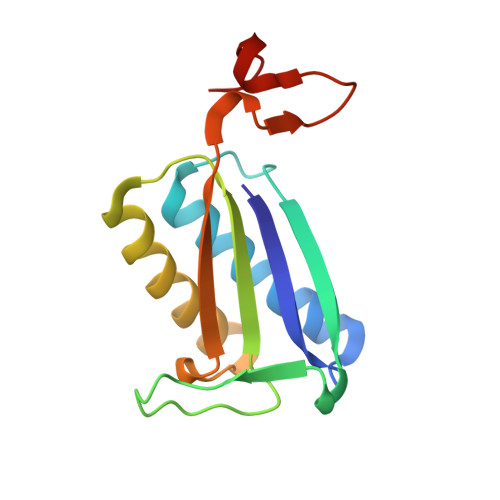Crystal Structures of the Wild-Type, P1A Mutant, and Inactivated Malonate Semialdehyde Decarboxylase: A Structural Basis for the Decarboxylase and Hydratase Activities
Almrud, J.J., Poelarends, G.J., Johnson Jr., W.H., Serrano, H., Hackert, M.L., Whitman, C.P.(2005) Biochemistry 44: 14818-14827
- PubMed: 16274229
- DOI: https://doi.org/10.1021/bi051383m
- Primary Citation of Related Structures:
2AAG, 2AAJ, 2AAL - PubMed Abstract:
Malonate semialdehyde decarboxylase (MSAD) from Pseudomonas pavonaceae 170 is a tautomerase superfamily member that converts malonate semialdehyde to acetaldehyde by a mechanism utilizing Pro-1 and Arg-75. Pro-1 and Arg-75 have also been implicated in the hydratase activity of MSAD in which 2-oxo-3-pentynoate is processed to acetopyruvate. Crystal structures of MSAD (1.8 A resolution), the P1A mutant of MSAD (2.7 A resolution), and MSAD inactivated by 3-chloropropiolate (1.6 A resolution), a mechanism-based inhibitor activated by the hydratase activity of MSAD, have been determined. A comparison of the P1A-MSAD and MSAD structures reveals little geometric alteration, indicating that Pro-1 plays an important catalytic role but not a critical structural role. The structures of wild-type MSAD and MSAD covalently modified at Pro-1 by 3-oxopropanoate, the adduct resulting from the incubation of MSAD and 3-chloropropiolate, implicate Asp-37 as the residue that activates a water molecule for attack at C-3 of 3-chloropropiolate to initiate a Michael addition of water. The interactions of Arg-73 and Arg-75 with the C-1 carboxylate group of the adduct suggest these residues polarize the alpha,beta-unsaturated acid and facilitate the addition of water. On the basis of these structures, a mechanism for the inactivation of MSAD by 3-chloropropiolate can be formulated along with mechanisms for the decarboxylase and hydratase activities. The results also provide additional evidence supporting the hypothesis that MSAD and trans-3-chloroacrylic acid dehalogenase, a tautomerase superfamily member preceding MSAD in the trans-1,3-dichloropropene degradation pathway, diverged from a common ancestor but retained the key elements for the conjugate addition of water.
Organizational Affiliation:
Division of Medicinal Chemistry, College of Pharmacy, The University of Texas, Austin, Texas 78712-1074, USA.














